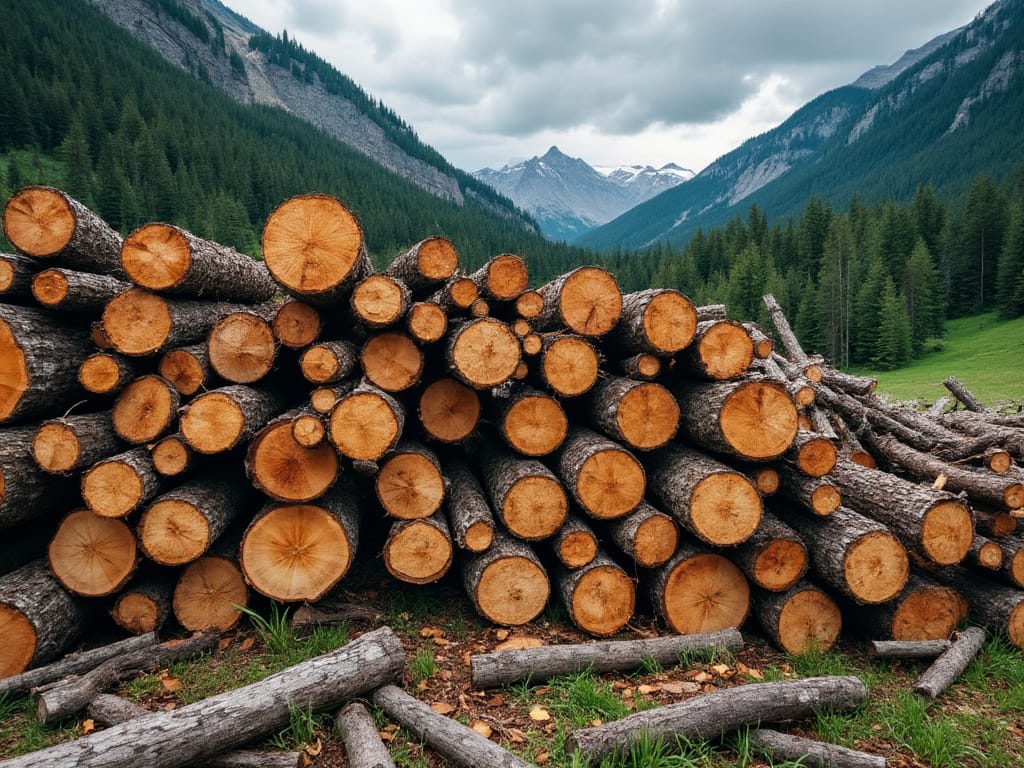Stop Wasting Time Drying Logs: Green Wood Myths Busted

Stop telling people to dry their logs before building.
You don't need to. It's a myth that you MUST always dry/season your logs/lumber before building.
Sheesh. It's so annoying seeing people spread this misinformation. No...I don't care how long you've been a "builder" or if you "built with green wood and now everything is warped and cracked." You probably did it wrong and think that every cabin ever built is the same. If you believe that, you probably also believe that you must wait a year or two to build.
No! No, you don't.
Let's take this cabin building all the way back to the pioneer days. They usually didn't dry their logs or timber. They built with "green" wood.
Was there some cracking and twisting and warping? Of course there was. As there will be if you dry your logs first... only the warping, cracking, and twisting happens before you build, and you waste a year waiting on building your cabin. That's a whole year (or two in some cases) wasted!
The wood is going to warp, crack, and twist no matter what you do. Also... the amount your logs warp, crack, and twist is based on your relative temperature and humidity.
It's basic physics. It's really not complicated at all.
All trees are made from cellulose. Different species of trees and different regions in the world have different climates and relative humidity.
The key here is that EVERYTHING IS RELATIVE.
A log cut in a humid climate is going to dry slower than a log cut in a dry climate.
Logs will shrink. Yes. But how much? It depends on many variables. Like I said... everything is relative. Species, water/moisture level in the tree/wood, climate, temperature, relative humidity, etc., all have a major effect on the time it takes to dry and how much shrinking, warping, cracking, and twisting the logs do.
How much will a log shrink? It doesn't matter. It doesn't matter if you want a shelter. The pioneers needed shelter. They didn't have the luxury of waiting a year to "season" or dry their logs.
Come on. This idea is being spread around that you absolutely must dry your logs and never build with green wood.
Let me make this crystal clear: ALL THAT IS PERSONAL OPINION!
It's not based in scientific fact.
Physics and math don't lie. Will the logs shrink? YES! Absolutely they will. Will they warp, crack, and twist? YES! Absolutely they will.
The question is, how much will they warp, crack, and twist, and does it really matter?
No. It doesn't matter. Unless of course you're a professional cabin builder brand that doesn't want the negative press from people who never built anything in their lives when they see cracks or warped logs or twists in some of the logs—not knowing that this is normal when wood dries.
The cellulose fibers are fairly close together, and when wet, the log is not only heavier; it's less dense because of that space between the cellulose fibers. When the water/moisture inside evaporates, the fibers "shrink," and the space between them gets smaller. This is where the warping, cracking, and twisting come into play.
How much does a log shrink? Well, it's all relative. It depends on the species of tree, the temperature, and the humidity—how fast a log can dry.
- Radial Shrinkage (width): Wood generally shrinks about 2-8% across its width (radial shrinkage). The exact percentage depends on the species; hardwoods tend to shrink more than softwoods.
- Tangential Shrinkage (thickness): This occurs across the growth rings and tends to be more substantial, around 5-12%. Tangential shrinkage is often about twice that of radial shrinkage, which can lead to cracking and warping.
- Longitudinal Shrinkage (length): This is minimal, usually around 0.1-0.2%. Wood usually remains relatively stable along its length when drying, but some species experience slight shrinkage.
The faster it dries, the more it deforms as the fibers in the log shrink and pull inwards.
Is it "safe" to build with green wood?
Let’s tackle the question lurking behind all this debate: is it safe to build with green wood?
The answer is a resounding yes. Historically, millions of structures—cabins, barns, homes, and more—were built with green wood and have stood for decades, even centuries. The pioneers, settlers, and builders who didn’t have access to pre-dried lumber weren’t building with any less care or safety. They used what they had, and these structures endured.
When it comes to safety, there’s no evidence to suggest that green wood is inherently less stable than dried wood. Wood’s natural process of shrinking and warping as it dries doesn’t weaken it; it simply changes its shape. Any shifting or cracking that occurs is largely aesthetic and does not compromise the structural integrity. A properly constructed building made with green wood is just as safe and sound as one made with dried wood.
In fact, in many ways, green wood construction can actually offer an advantage in strength. The moisture within green logs allows them to compress and settle together over time, making for a tighter fit and stronger overall structure. While dried logs may require additional chinking or maintenance to stay secure as they move with seasonal changes, green logs “lock in” more naturally.
So, yes—it’s entirely safe to build with green wood. The notion that dried wood is the only safe option is another modern misconception, rooted more in aesthetic preference than in structural necessity. For those willing to work with natural materials as they are, green wood offers a perfectly safe, time-honored building solution.
Incorporating a Bit of Science:
Understanding the science behind wood can also help clarify why drying isn’t always necessary. Wood is hygroscopic, meaning it continuously interacts with the moisture in its environment. Cellulose fibers in the wood swell and contract depending on moisture levels, leading to shrinkage as the log loses water. This behavior doesn’t stop just because the wood is “dried.” Instead, the shrinking, expanding, and contracting continue based on environmental conditions. Drying simply shifts this natural process, and once we accept that wood’s relationship with moisture is ongoing, it becomes clear that building with green wood simply means accommodating this natural cycle from the start.
Clarifying Myths vs. Facts:
The idea that logs must always be dried before building is based more on preference than on universal truth. Wood is a dynamic material, and factors like temperature, humidity, species, and climate play massive roles in how it behaves. These variables affect drying time, shrinkage, and warping, making wood’s behavior highly situational. Applying one-size-fits-all advice—like the need to dry logs before building—ignores the reality that different environments lead to different outcomes. In some climates, wood will dry more evenly or quickly, while in others, the process is much slower. Recognizing this relativity helps debunk the myth that drying is a non-negotiable rule for all builders, everywhere.
Highlighting Practical Considerations:
Waiting to dry logs adds unnecessary time to the building process, often leading to a delay of a year or more. For anyone seeking quick shelter, this wait can be costly and inconvenient. The reality is that drying logs first isn’t universally required for a stable, solid structure. Many builders have successfully constructed with green wood, resulting in structures that are perfectly functional. By avoiding the wait, you not only speed up the process but also work with the wood’s natural changes as they occur within the structure itself. In the end, getting a roof over your head sooner rather than later often outweighs any small advantages of dried wood.
Tackling Aesthetics vs. Functionality:
A lot of the concern about building with green wood comes from a misunderstanding of aesthetics versus functionality. Yes, green wood may warp or crack as it dries, but these are mainly visual changes that don’t typically affect the structure’s integrity. Cracks and slight warps are natural responses of wood to drying; they don’t weaken it. Traditional log cabins have cracks and checks, and that’s a big part of their character. When people understand that these changes are a natural part of wood’s aging process, they can appreciate them as part of the cabin’s rustic charm rather than as flaws.
Historical Perspective:
When we look back at how cabins and homes were built by pioneers, one thing stands out—builders weren’t waiting years to dry their logs. Green wood, or unseasoned wood, was a standard building material because time was of the essence. People needed shelter quickly, and they didn’t have the luxury of waiting for wood to season. Many of these structures, despite being made from green wood, have stood the test of time, proving that drying isn’t a prerequisite for longevity. In fact, some structures built this way have survived decades, even centuries, in their natural state. This historical context shows that drying wood before building is a modern convention, not a necessity for durability.
So, before you commit to the lengthy process of drying logs, consider the practicality, the history, and the science behind green wood. For generations, builders have relied on green wood to construct homes that are sturdy, safe, and long-lasting. The belief that logs must be dried first is a modern preference, not a requirement.
Building with green wood is efficient, resilient, and rooted in natural methods that have stood the test of time. Embrace the imperfections, the character, and the authenticity of green wood—it’s more than enough to get the job done.





